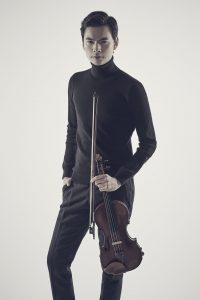Stefan Jackiw Illuminates Beethoven’s Violin Concerto and Rafael Payare Unleashes a Heady Shostakovich Symphony No. 11
When I heard violinist Stefan Jackiw and pianist Conrad Tao play a movement from Olivier Messaien’s Quartet for the End of Time at La Jolla’s 2019 SummerFest, I was immediately transfixed by the depth of their interpretation. Jackiw’s radiant sonority and acute focus allowed him to stand out in a festival replete with stellar violinists.

Stefan Jackiw [photo (c.) Sungwook Lee]
Once Jackiw put his bow to the violin in the Beethoven, it became clear that my apprehension was completely unwarranted—actually, foolish. That exquisite, luminous line he employed for Messaien worked wonders on the Beethoven Concerto, and his supple phrasing and crystalline trills brought a refreshing clarity to this 1806 concerto that too many soloists overplay as if it were a first cousin to the later Mendelssohn or Brahms Violin Concertos.
On the podium Payare encouraged his players’ ebullient energy without unduly thickening the texture. He made room for the audience to savor the many duets between the soloist and members of the orchestra, especially those in the first movement with Principal Bassoon Valentin Martchev and with First and Second Trumpets Christopher Smith and John MacFerran Wilds. Jackiw’s gleaming first movement cadenza floated through Copley Symphony Hall with breathtaking panache.
Unlike his mentor Haydn, Beethoven contributed little to the sacred music canon, but I found Payare’s approach to the hymn-like “Larghetto” warmly spiritual. He appropriately allowed the orchestra to flex a suitable amount of muscle in the giddy “Rondo” finale, and Jackiw’s fleet pyrotechnics brought roars of approval from the ample Symphony Hall audience.
Unlike most visiting soloists, Jackiw declined to play an encore, but I think that was the right decision. His performance of the Beethoven Violin Concerto was exceptionally complete, marvelously structured and elegantly detailed. Why should he sully his listeners’ memories with some kitschy Fritz Kreisler bon-bon?
Payare opened his first season with the Mahler Fifth Symphony and will end the season with Beethoven’s Ninth Symphony. So it is no surprise mid-season that he offered another symphonic giant, Dmitri Shostakovich’s towering, hour-long Symphony No. 11 in G Minor, The Year 1905. The composer cleverly said rather little about this apparently programmatic symphonic work, although the subtitle’s evident link to the revolutionary acts in 1905 Russia as well as the quotation of numerous Russian 19th-century revolutionary songs in the symphony overtly ties the work to the events in January, 1905, when the Czarist military killed Russian workers in a peaceful protest march on the Czar’s Winter Palace in St. Petersburg.
But Shostakovich completed the work in 1957, only a year after the Soviet Union flexed its military might to crush the Hungarian Revolution, and many listeners along with some historians see Symphony No. 11 as a bitter description of the Soviet repression of that 1956 revolt in Budapest. However you interpret Symphony No. 11, it is a powerful work of epic proportions, from the eerie quiet of the opening movement—“The Palace Square” ominously before the march—to the frightening orchestral fury of the military attack—“The 9th of January”— to the haunting elegy of the third movement—“In Memoriam”—and, finally, the violent, almost cataclysmic rage of the concluding movement—“The Alarm.” After all of that drama, Shostakovich gives the English Horn the last word, an extensive cantilena, played with poignant sensitivity by Andrea Overturf.
Payare paced the work adroitly, skillfully building its ferocious climaxes, yet keeping his listeners consistently engaged in long stretches of ominous brooding and suggestion. The orchestra’s command was laudable throughout, but allow me to praise the viola section—their excellence is too easily overlooked—for their touching, plaintive lament that dominates the end of the third movement.
This concert by the San Diego Symphony was presented February 21 & 23, 2020, in the Jacobs Music Center’s Copley Symphony Hall. The February 23 concert was heard for this review. The Jacobs Masterworks Series continues February 28 & 29, 2020, with a program of Sibelius and Rachmaninoff led by guest conductor Run Sun Kim.

Ken Herman, a classically trained pianist and organist, has covered music for the San Diego Union, the Los Angeles Times’ San Diego Edition, and for sandiego.com. He has won numerous awards, including first place for Live Performance and Opera Reviews in the 2017, the 2018, and the 2019 Excellence in Journalism Awards competition held by the San Diego Press Club. A Chicago native, he came to San Diego to pursue a graduate degree and stayed.Read more…
